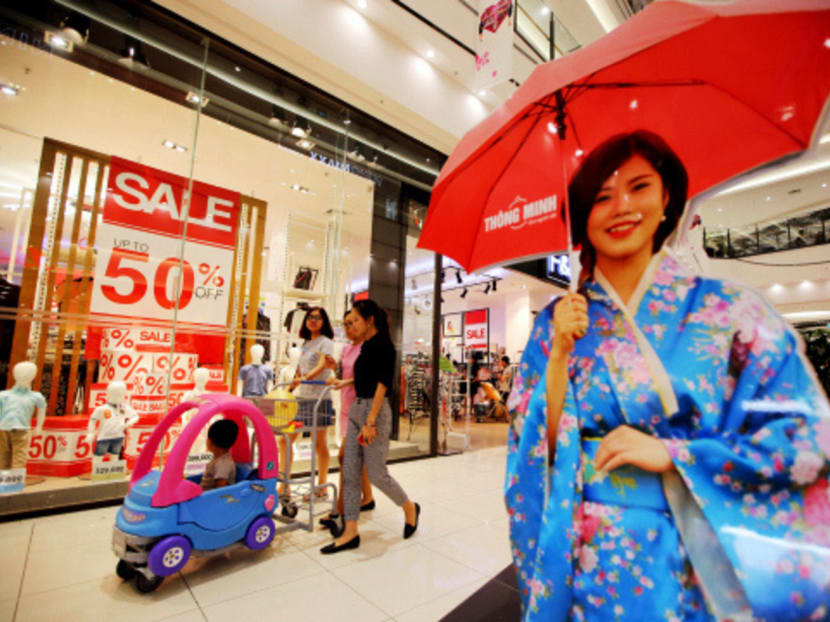As Japan greys, retailers covet youthful masses in Vietnam
These days, Ms Thu Huong no longer shops at the fresh produce market near her home, opting instead to hop in a taxi and head off to Aeon’s 9-month-old mall in Hanoi. There, as she shops for her family of five, she can bask in the air-conditioning and enjoy free Wi-Fi.

Aeon Mall in Hanoi. Vietnam, with a rapidly expanding middle class, is an alluring alternative to Japan for retailers such as Aeon. Photo: Bloomberg
These days, Ms Thu Huong no longer shops at the fresh produce market near her home, opting instead to hop in a taxi and head off to Aeon’s 9-month-old mall in Hanoi. There, as she shops for her family of five, she can bask in the air-conditioning and enjoy free Wi-Fi.
“It’s very convenient to shop there, I can buy all the different things that my family needs for a whole week. I also feel more modern and fancy when shopping in a place like this,” said the 30-year-old dairy company employee.
With a young population, an expanding middle class and one of South-east Asia’s fastest-growing economies, Vietnam is an alluring market for Aeon, Takashimaya and Seven & I Holdings. The reason: China is slowing and growth is flat-lining at home.
“The Vietnamese economy is growing rapidly and its middle class is explosively expanding,” said Mr Nagahisa Oyama, who oversees Vietnam operations as Aeon’s chief there. “Its retail market is growing very quickly with strong appetite for spending, especially among young people.”
And there are plenty of them in the nation of 93 million. Almost 60 per cent of Vietnam’s population is under 35 years old and they are becoming better educated, according to market research company Nielsen Vietnam.
Four days after an Aeon Mall opened in Ho Chi Minh City on July 1, it recorded sales 18 per cent higher than originally estimated, according to the company.
Aeon, Japan’s largest retailer by sales, currently operates four malls and 54 supermarkets in Vietnam. It is not the only Japanese firm looking to reap profits in the Vietnamese market. About 20 consumer companies from Japan — from a chocolate maker to noodle company — met potential Vietnamese partners this month at an investment conference in Hanoi organised by Mitsubishi UFJ Financial Group and Vietnam JSC Bank for Industry and Trade.
Japanese corporations are increasingly looking outside home for growth. Aeon recorded a net loss for the March to May period, its third quarterly loss within a year as a declining and increasingly frugal Japanese population capped sales.
The world’s fastest-ageing major nation saw its Japanese population drop the most on record, falling for a seventh straight year in 2015.
By contrast, Vietnam’s young demographic is also bolstered by growing average incomes which rose to US$2,111 (S$2,865) last year compared with just US$433 in 2000, according to World Bank data.
Consumers in Vietnam increasingly desire better quality shopping experiences, prompting the country’s retail model to evolve from one mainly dominated by neighbourhood wet markets that sell fresh produce, according to Nielsen Vietnam.
The country has nearly 9,000 wet markets, 800 supermarkets and more than a million small stores run by individual households, according to a government report in June. Spending at formal retail stores and centres, as opposed to traditional local shops, is expected to rise to 40 per cent of consumer spending by 2020, up from 25 per cent currently, the report showed.
Vietnam’s retail shift took off two years ago, aided by “both local giants and multinational companies who are accelerating their development to build a solid footprint,” said Mr Roberto Butragueo, Nielsen Vietnam associate director of retail services.
Shoppers in the country are also becoming more demanding. While six in 10 Vietnamese expect stores to be within reach, nearly as many also want them to be organised in a way that enhances the shopping experience, according to Nielsen.
Department store operator Takashimaya opened a 15,000sqm department store in the Saigon Center in Ho Chi Minh City this month, its first in the country to tap faster-growing markets abroad, especially in South-east Asia, said spokesman Hironobu Hanai.
Vietnam’s young population and high growth rate are attractive, and Takashimaya has invested about ¥5 billion (S$65 million) into the nation since 2012, including in the new store and other real estate, said Mr Hanai.
And the interest is not limited to Japan, as Korean retail conglomerate Lotte Group targets to open 60 supermarkets in Vietnam by 2020, while Thailand’s TCC Holding acquired Metro AG’s Cash & Carry wholesale business in Vietnam for €655 million (S$978 million)
Homegrown retailers are pushing back. Hanoi-based Vingroup aims to open as many as 500 supermarkets and 8,000 convenience stores under its VinMart and VinMart+ brands in the next five years, even as large retailers from overseas have “created difficulties for local companies”, said the property developer.
Mobile World Investment, Vietnam’s top mobile-phone retailer, plans to launch grocery stores next year. This new segment is expected to grow much faster than its mobile phone and consumer electronics retail business, said Chairman Nguyen Duc Tai in an interview.
“The market is very huge here. People change mobile phones only every two years on average while they have to buy fresh food and meat every day,” said Mr Tai. “Ten years ago, you see women carrying plastic bags to the wet markets to buy food every morning, but you may not see this image in the future. This is what we call ‘generation change’.” BLOOMBERG






